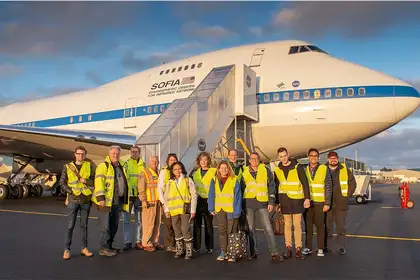
Dr Severne with other science communicators and advocates about to board SOFIA.
Massey University’s Assitant Vice-Chancellor Māori and Pasifika Dr Charlotte Severne, Ngāti Tūwharetoa, got an opportunity of a lifetime last week - to take a flight with NASA’s airborne Stratospheric Observatory for Infrared Astronomy, SOFIA.
Dr Severne was part of a select group of New Zealand science communicators and advocates invited aboard one of the programme’s 19 overnight missions from Christchurch. The New Zealand programme aims to observe celestial bodies too low to observe or not visible at all from the Northern Hemisphere, including our neighbouring galaxy the Large Magellanic Cloud, the centre of our own Milky Way galaxy, and Saturn's moon Titan.
The unique Boeing 747SP, is fitted with a 17-ton giant gyro-stabilised highly-sensitive 2.7m-diameter telescope that peeks out of the plane once it reaches an altitude of 10.6km.
SOFIA’s ability to study mid- and far-infrared wavelengths (28–320 microns) provides data that cannot be obtained by any other current astronomical facility on the ground or in space, including those now under development.
Dr Severne says being onboard for this mission, observing other galaxies magnetic structures from this highly adapted flying laboratory was the field trip of all field trips. “Everyone had a role on board. There were specialists in engineering, telescopes, astronomy, IT and then of course the pilots and their flight engineer - they were a privilege to observe. Carrying a military emergency oxygen system everywhere along with a two hour emergency procedures briefing served to remind me that there were risks in flying at high altitudes with kit hanging out the back of the plane.”